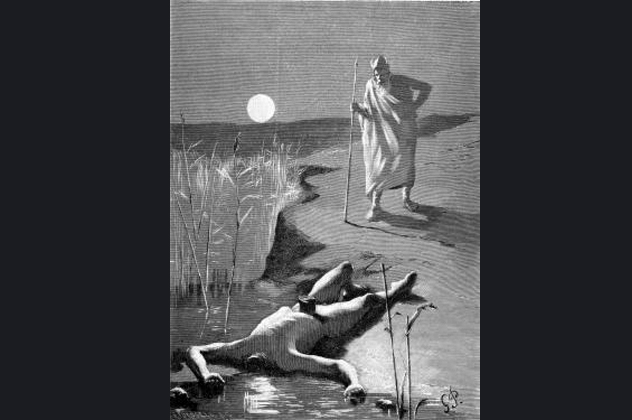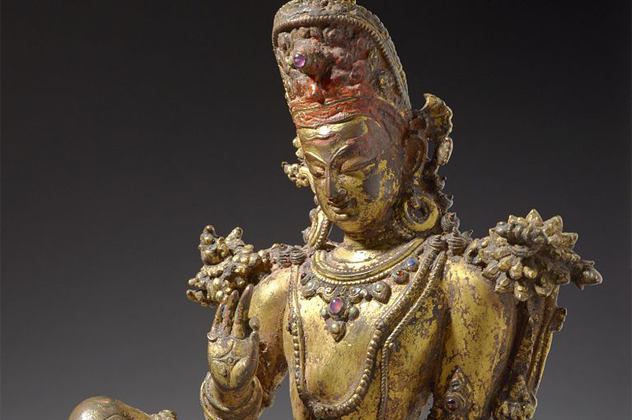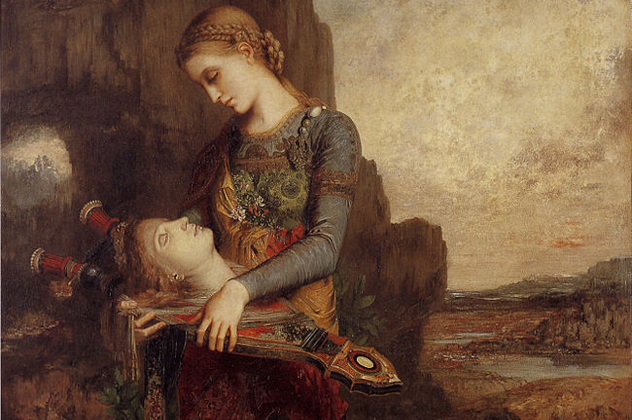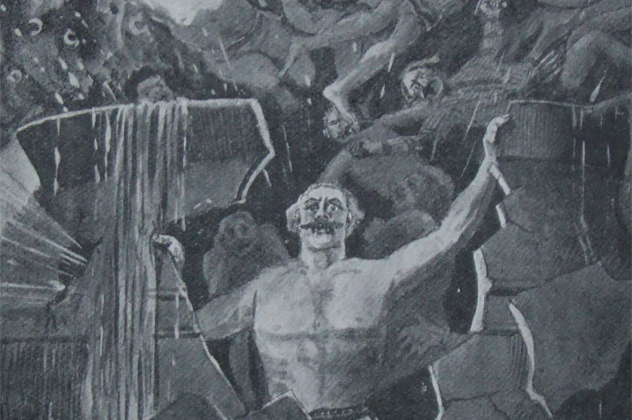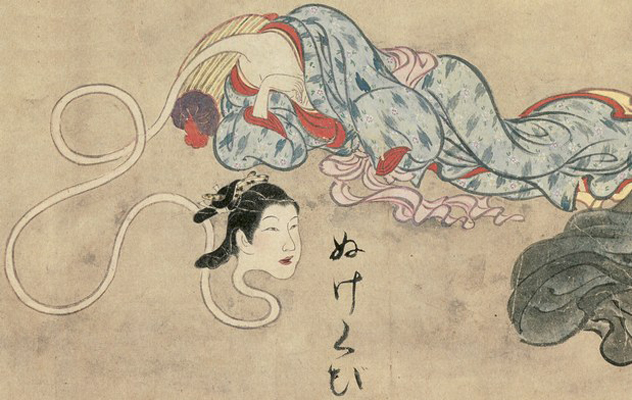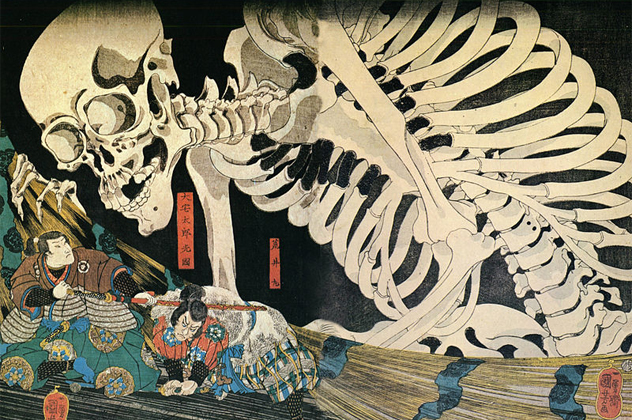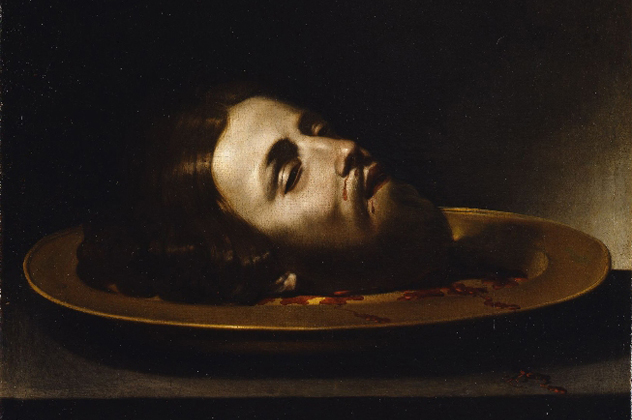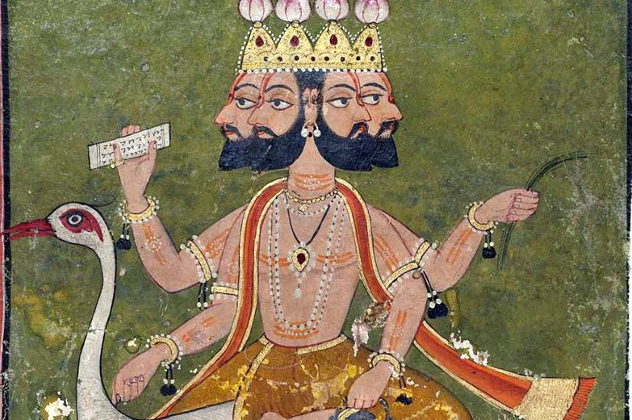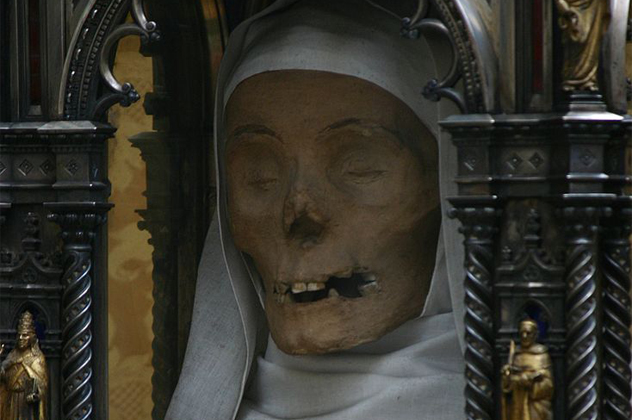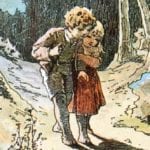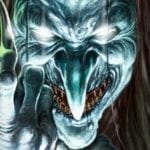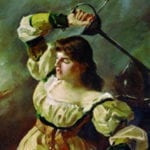10Born From Severed Head Spit
The old K’iche’ Mayan story of creation is called the Popol Vuh. In it are the lords of the underworld, One and Seven Death, who hated the noise made by the games that the people on Earth played. One day, two brothers, One and Seven Hunahpu, played a game wild enough to arouse their ire. The demon lords of death invited them into the underworld, Xibalba, for a ball game in which they planned to kill the boys. With no mention of murder in the invitation, the brothers accepted. They quickly found out that Xibalba was a cruel place. Even those personally invited by the lords of death had to navigate devious traps and tests designed to humiliate, maim, and kill them. The brothers traversed rivers of scorpions and blood, but ultimately failed the tests awaiting them. They ended up spending the night in an area known as the Dark House, and the next day they were sacrificed by the evil gods. One Hunahpu’s head was removed and hung in an underworld calabash tree. But the underworld has many inhabitants, including a woman named Blood Moon. On a visit to the same tree, One Hunahpu’s skull spit into her hand, which impregnated her. Her father, disgraced at having a pregnant daughter with no husband, attempted to sacrifice her for her promiscuity. Blood Moon managed to escape her father’s wrath by fleeing to the Earth’s surface, where she met One Hunaphu’s father and convinced him that she was pregnant with his grandchildren. Twins were born, Hunahpu and Xbalanque, who later found their father’s sports equipment. Their game again angered the underworld lords, who invited them to play a game in their personal court. Unlike their father, however, the brothers passed all the tests and met the death lords. They played a series of ball games against them, after which the brothers slept in increasingly dangerous parts of the underworld. Finally, the Bat House proved deadly for Hunahpu, whose head was snatched off by an underworld bat when he looked up to see the dawn. But fortune was smiling on Hunahpu—the next day, the gods mistook a rabbit for the ball and left to retrieve it. While they were gone, his head was retrieved and reattached. The hero brothers won the last game against the demon gods, but in their anger the gods built a fire pit and challenged them to a game of leaping over it. This time, the brothers saw how the gods obviously planned to kill them, so they leaped into the fire themselves to deny the lords the pleasure. Sometime later, they were reincarnated as vagabonds who could perform magical feats. Intrigued by their power and curious as to who the vagabonds were, the gods of death summoned them to their court. There, the brothers proved that they knew how to bring the dead back to life. Intrigued by this power, One and Seven Death demanded to be killed and resurrected. The brothers, however, only performed half of their miracle, and killed them without following through with the resurrection. After resurrecting their father, they ascended into the sky and gained dominion over the Sun and Moon.
9Mimir’s Wise Pickled Head
According to Norse legend, there was one (or possibly two) beings named Mimir. Both were associated with wisdom, which became a matter of confusion for scholars since it made it difficult to decipher which one ancient texts referred to, or even if they referred to a single person or separate beings. One Mimir was the spirit guardian of the well of wisdom and knowledge. It was this Mimir who bestowed Odin’s famed wisdom on him by letting him drink from the well in exchange for placing the Allfather’s eye in it as a pledge. Assuming there are two Mimirs, the other was a wise god sent with Odin’s handsome but slow-witted brother Hoenir to the Vanir. The families of gods had previously been warring, and the two gods were given to them to seal a peace treaty. The Vanir took such a liking to Hoenir that they made him a chief among them. But his stupidity eventually shone brighter than his nice smile, and it soon became clear that the god could do or say nothing of value without Mimir’s council. The Vanir, angered by his worthlessness and thinking they had been tricked, cut off Mimir’s head in a fit of rage. Bereaved at the loss of Mimir, Odin obtained his head and preserved it through a magical pickling process. The head, still able to converse, was set beside the other Mimir’s well, where the Allfather would consult it whenever he needed advice.
8Dadhyanc Atharvana’s Replacement Horse Head
There is no one founder or core set of teachings that Hinduism agrees on, so its stories are varied and can at times even be conflicting. It’s often thought of as a family of religions instead of a unified framework of beliefs. The story of Dadhyanc Atharvana, likewise, has a few different—even parallel—versions, but they all agree that he lost his head revealing the secret of brewing mead. Dadhyanc knew the secret of making mead from honey. The god Indra, however, warned him that if he ever revealed it to anyone, he would cut his head off. But mead being mead, there were scores of gods and humans who wanted to brew some for themselves. Among them were the Asvins, the two sons of the Sun god. They approached Dadhyanc with an offer: If he told them the secret of mead-making, they would surgically remove his head and replace it with a horse’s. Then, when Indra lopped it off, they would just replace his original. Things worked out exactly as the brothers had hoped. Dadhyanc was eager to spread the gospel of mead, and Indra, fooled by the horse head, severed it only for the Asvins to replace Dadhyanc’s original.
7Orpheus’s Singing Head
The son of a muse, Orpheus was a Greek mythological hero who possessed godlike musical skills. Aside from joining the expedition of the Argonauts, the musician’s most famous story is his journey into the underworld to reclaim Eurydice, his lost wife. Despite persuading Hades to release her with his musical prowess, Orpheus’s ultimate failure to recover his wife threw him into a deep depression. Legends differ on exactly what happened next, but most have the musician spurning the love of other women for a period of years. (Some even have him forsaking women completely and encouraging homosexuality.) Whether because he spurned the advances of the women of Thrace or because he apostatized against Dionysus, which occurs in another tale, Orpheus was eventually ripped limb from limb. His head was then nailed to his lyre, which fell into the ocean and washed up on the shore of Lesbos. The head refused to rest, however, and began an endless prophetic chorus. The Lesbians installed it in a cave where it became a popular pilgrimage spot. Since Orpheus’s head needed no muse, it eventually usurped the Lesbian oracles’ positions, which became a topic for later poets. Some legends even have it becoming so popular that it angers Apollo, who finally tells it to shut up because he’s tired of hearing it.
6Bran The Blessed’s Jolly Head
According to Celtic mythology, Bran Fendigaid was the giant son of the sea god. In an effort to unite the Celtic powers even at the cost of family, he gave his sister, Brawwen, into marriage to the Irish king Matholwch. But Bran’s brother, Efnisien, was not as enthusiastic about the plan as his brother. He was outraged at the gift of his sister to the king and threw such a fit that Bran had to pacify him by giving him a magic cauldron. But it turned out that Efnisien hadn’t been far off the mark. Years later, Matholwch was persuaded to send his wife away from court into the kitchens. Hearing about how his sister had been dishonored, Bran crossed the Irish Sea to confront Matholwch and rescue his sister from a servant’s life. On seeing the Welsh forces, Mathlowch fled. Eventually, a truce was reached where he abdicated his throne and gave it to Branwen’s son, Gwern. During the celebration feast, however, rowdy Efnisien threw Gwern into a fire and killed him. War ensued, with Efnisien using the magic cauldron Bran had given him to reanimate his dead soldiers. It was a fierce battle that ended in a draw. Bran himself was poisoned in the foot by a dart but survived long enough to ask the seven survivors on his side to sever his head and bury it in Gwynfryn, where London Tower now stands. The seven survivors returned to Britain, apparently in no hurry to fulfill their leader’s wish. They stayed at Harlech for seven years while Bran’s head, still talkative and jolly, entertained them. Later, they moved on to Gwales, where they were put under a kind of spell for 80 years while enjoying the happy head’s company. The spell ended once someone by chance opened the doors to the hall, and the loyal men returned to their senses and resumed their journey. Finally, 87 years after the journey began, they buried the head in London facing Europe as a charm against invasion.
5Isogai And The Rokurokubi Heads
Legend says that Isogai Heidazaemon Taketsura was the greatest samurai of Lord Kikuji of Kyushu. But when his retainer’s house eventually came to ruin, Isogai gave up being a samurai to become a traveling Buddhist priest. It was a violent age, and although Isogai wore the robes of a priest, he was still a samurai at heart. He went wherever the road took him, no matter the danger or discomfort. One day, with nothing but a rock for a pillow, Isogai found himself sleeping outside near the road. A woodcutter came along and saw Isogai sleeping out in the open. He offered him a room in his cottage. When they reached it, Isogai found four other people there who greeted the priest in a manner too cultured for common peasants. When Isogai asked them if were once people of some distinction, the woodcutter confirmed that they were once a noble house but had fallen to ruin though his own selfishness. Moved by the man’s humility and his kind treatment of him, Isogai promised to recite the sutras for him later that night. Later, the priest went out for a drink and saw the bodies of his five hosts lying headless on the floor. There was no blood, though, nor did it look like there had been any struggle. Isogai realized that he was in the lair of the rokurokubi, spirits whose heads could detach from their bodies. (Other descriptions of the spirits say that they grow incredibly long necks.) Following an old saying that the creatures could be killed by moving their bodies while their heads were disconnected, Isogai dragged the body of the woodcutter to a nearby grove. The heads were floating about chatting and eating insects when they discovered him. When they attacked, Isogai uprooted a tree and began swatting them like flies. Most of the heads fled, except the woodcuttter’s, which had managed to bite down on Isogai’s sleeve so hard it couldn’t be removed even after it died. Having a head on his sleeve didn’t seem to bother the hearty priest, though, who kept it as a souvenir. When he arrived in the next town with a head swinging from his sleeve, the police thought he was a deranged murderer and arrested him. Fortunately for Isogai, one of the magistrates judging him recognized the head for what it was and released him.
4Masakado’s Vengeful Flying Head
Taira no Masakado was a Japanese rebel leader descended from one of Japan’s earliest emperors. He began his career as a daimyo (warlord) who constantly skirted the line between a normal feudal ruler and an outright outlaw. He finally stepped over the line with an attack on the Hitachi provincial government compound after intervening in a squabble between officials. The exact motives for his next move are debated, but Masakado proclaimed himself emperor and started seizing control over east Japan. The ruling emperor naturally took issue with an unwanted rival and declared him an enemy of the state. Within two months, Masakado was dead. His head was hung on a rack in the corner of a busy street as a warning to any more would-be usurpers. That was when people started seeing the head grinning at them. Others said it opened its eyes and looked at them, grinding its teeth as they walked pass. Finally, it’s said that when a poet approached it, the head called out its desire to continue the fight against its enemies. Thunder and lightning pealed through the clouds, and the head suddenly took to the sky in search of its body. It was said to have landed on a hill in Tokyo, where a tomb was built for it. The hill on which it fell is thought to be cursed. The strange occurrences that happen there are said to be the results of the head displaying its anger at those who disturb it. In 1871, Japan’s new Meiji government built its Ministry of Finance over the site, but since the head’s shrine was left intact, no troubles were reported. Then, in 1923, the Great Kanto earthquake burned the Ministry of Finance to the ground. When the Ministry of Finance was being remodeled, they excavated the tomb and found it empty. Believing that nothing had ever been there in the first place, they leveled the tomb mound and erected a temporary building there. Within two years, 14 men were dead, including the Minster of Finance himself. Rumors spread that Masakado’s sprit was behind it, and the new building was leveled and the tomb rebuilt. On June 20, 1940, very close to the day of Masakado’s death, lightning struck nearby and burned down the Ministry. After a purification rite, though, there seemed to be no more trouble. The only thing slightly unusual was that, when the area was bombed by US forces, the tomb remained untouched. But when American infantry tried to build a motor pool over the mound, the bulldozer that was trying to level it flipped over and killed the driver. Locals persuaded the occupation forces to cancel their construction plans and cooperate in restoring the site. Whether it was a string of coincidences or the wrath of an angry flying head, that’s two governments that have decided the site is better off left alone.
3The Queen’s Bloody Head On A Platter
Although King Arthur had a number of bizarre adventures, this story is a little more over-the-top than most of the Arthurian legends, and it’s possible that it was actually written as a parody on the more well-known tales. According to a Welsh tale of uncertain origin, King Arthur once embraced his wife during a feast and gave her a long, passionate kiss. Embarrassed, Guinevere got angry at the public display of affection and accused Arthur of knowing nothing about women. Arthur, in typical chivalric style, immediately mounted up on a quest and declared that he would not eat until he had discovered the nature of women. Gathering two of his knights, Arthur rode out in search of answers. His first stop was the court of nearby king Gorgol, a king renowned for his wisdom. Gorgol convinced Arthur to sit down and eat with a promise that he would explain women the next day. When the time came for the big reveal, though, he instead sent Arthur off to his brother. When the brother did the same thing and sent him to yet another sibling, Gorlagon, Arthur refused to dismount and eat until Gorlagon told all. So Gorlagon told him a story. There was once, he said, a king who had a special sapling. If the sapling was cut and used to strike the king, he would turn into a wolf. Somewhat mirroring the biblical Samson, the king guarded the tree and its secret from everyone until his wife eventually got him to reveal his weakness. And just like Delilah, the queen was anything but faithful. She was having an affair with their steward and used the sapling to turn the king into a wolf. Fortunately for the king, though, she had forgotten the part of the spell that gave him the mind of one. In wolf form, the king ran off into the woods and started killing his wife’s relatives. Eventually, pressed upon by hunters, he was forced to flee the country. He came to the land of a good and wise king and threw himself at his feet. The king, sensing something peculiar about the wolf, kept him as a pet. This king also had an unfaithful wife. When the wolf-king learned of the queen’s infidelity, he mauled the steward she was having an affair with. The queen, however, hid her son in the basement and told her husband that the steward had been injured trying to protect their son from the wolf. Having the mind of a man, the wolf-king just led his master to the child to prove that she was lying. The steward confessed and, because Welsh tales don’t play around, he was flayed alive and the queen was quartered—roped to four separate horses and torn apart when they ran in opposite directions. In the midst of all this, the king realized that his wolf was really a man. He let the transformed king lead him back to his own kingdom, where he fought to return it to him. Having had his fill of adulteresses, he tortured the queen until she revealed the secret of how to turn his wolf back into a man. Once restored, the king had his wife’s lover executed but let his wife live on the condition that she carried the bloody, decapitated head of her lover on a platter wherever she went. At the end of the tale, Arthur commented on a woman sitting opposite Gorlagon, who had cried throughout the entire retelling of the story and kissed a severed head whenever Gorlagon kissed his wife. Predictably, Gorlagon revealed that he was the king from the story. Arthur dismounted and ate, considering what he had learned about women from the tale. Unfortunately, the legend doesn’t tell us what he got out of it.
2Brahma’s Lustful Fifth Head
Another Hindu myth is how Brahma lost his fifth head. There are many stories with differing details, but most agree that the trouble with Brahma’s fifth head started when he created his daughter. After creating her, he developed a fierce and incestuous lust for the girl. One story says that at first Brahma had only one head, but when his daughter started walking around him as a sign of respect, he grew three others so he could constantly watch her. His fifth head was supposedly on top to keep his mind on higher things, a kind of last-ditch effort to retain the aestheticism that had allowed him to create beings. Still another story says that the fifth head was grown so he could watch his daughter when she ascended, tired of her father’s lust. It was said that when she rose to the sky, he finally asked her to make love to him. She spurned him and angrily told him that his fifth head was inauspicious. Some legends say that in Brahma’s anger, the fifth head started spewing fire that burned up all of the Earth’s water. Others say that it began helping demons devour the gods. Still others say that it shone so brightly that no one could see to move. Regardless of exactly what it was doing, the head had to go. Some stories have the god Rudra cutting off the head with his fingernails, while others have Shiva doing the deed. In both, the fifth head was slain and the world saved.
1St. Catherine Of Siena’s Severed Head
Saint Catherine was a 14th-century Catholic holy woman who was said to have had the gift of stigmata (the manifestation of the wounds of Christ). Some accounts even attributed with her the power of levitation. Though she was born in Siena, she died at the age of 33 in Rome, which Siena locals viewed as a tragedy—not only that she had died, but that she hadn’t done so locally. A local affiliated with the Siena church thought it best that her remains be brought back to her hometown for internment. The idea, however, was not welcomed by those in charge of her Roman tomb. So, unable to relocate her remains, the locals of Siena opted to steal her head. Legend says that her remains were damaged by the dampness of the simple Roman tomb, making the postmortem decapitation an easy task. The head was smuggled out of Rome in a bag. When the “liberators” of the head were stopped by guards, they prayed to the saint, whose head was said to briefly turn into rose petals for the inspection. Although the head thieves made it safely back to her hometown and placed the head in a local basilica, there have been periodic troubles at the site ever since. A fire that consumed the church almost consumed the head. Later, while the head was being carried in a religious procession, some of the locals attempted to steal it but instead dropped the relic on the road. Her head now sits safely behind glass at her home church. Her thumb is also nearby, and her foot is rumored to be in Venice. Nathan keeps a Japan blog where he writes about the sights and expat life and finds Japanese culture in everyday items. You can also find him on Facebook and Twitter.

